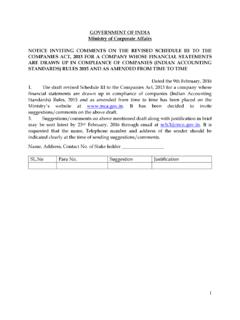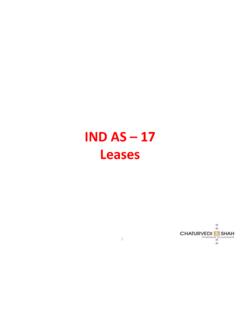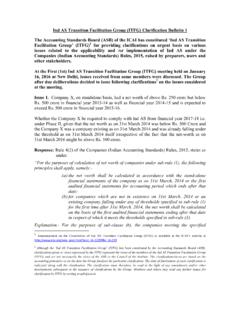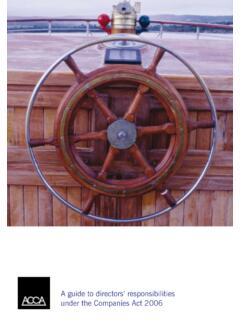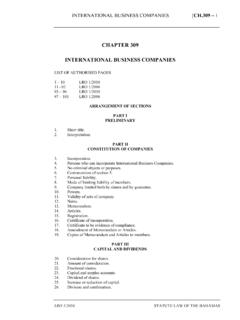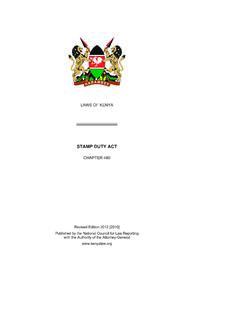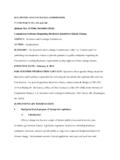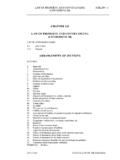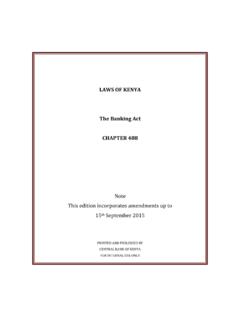Transcription of GN (A) 35 Guidance Note on Accounting for Depreciation in ...
1 Guidance Note on for Depreciation in companies Schedule II to the companies Act, 2013 The Institute of Chartered Accountants of India GN (A) 35 Guidance Note on Accountingfor Depreciation in companies in the context of Schedule II to the companies Act, 2013 The Institute of Chartered Accountants of India(Set up by an Act of Parliament) New Delhi Accounting for Depreciation in companies Schedule II to the companies Act, 2013 The Institute of Chartered Accountants of India Foreword Accounting for Depreciation is generally a significant matter for the purpose of true and fair determination of the operating results of a company as reflected in its statement of profit and loss as well as its financial position as depicted in its balance sheet. Though Accounting Standard (AS) 6, Depreciation Accounting has already been issued by the Institute, in the case of companies , some issues have arisen due to the practical application of Schedule II to the companies Act, 2013, in the context of AS 6.
2 With a view to provide an authoritative position of the Council of the Institute on the issues arising out of Schedule II to the companies Act, 2013, the Research Committee of the Institute has formulated this Guidance Note on Accounting for Depreciation in companies in the context of Schedule II to the companies Act, 2013. The publication is culmination of joint efforts of two sub organs of ICAI - Research Committee and Accounting Standards Board. I would like to compliment their respective Chairman CA. Subodh K. Agrawal, Past President and CA. Sanjeev K. Maheshwari, respective Vice-Chairmen, CA. Sanjiv Kumar Chaudhary, and CA. S. Santhanakrishnan and their all other members. I would also like to compliment other colleagues in the Council who have contributed immensely towards bringing out this publication.
3 I am confident that this Guidance Note will be immensely useful to the members of the Institute as well as to others concerned. Kolkata February 6, 2016 CA. Manoj Fadnis President Preface The Council of the Institute has previously issued various Guidance Notes on the subject of Accounting for Depreciation , with particular reference to companies , viz., Guidance Note on Accounting for Depreciation in companies and Guidance Note on Some Important Issues Arising from the Amendments to Schedule XIV to the companies Act, 1956. However, after the withdrawal of the above Guidance Notes since those were no longer relevant in accordance with the provisions of the companies Act, 2013, the Research Committee was requested to formulate a Guidance Note to provide Guidance on issues arising on practical application of Schedule II to the companies Act, 2013 for the purpose of providing Guidance on Accounting for Depreciation in companies .
4 In view of the above, the Research Committee of the Institute, took up the project to formulate a Guidance Note on Accounting for Depreciation in companies in the context of Schedule II to the companies Act, 2013 to be issued under the authority of the Council of the Institute, with a view to establish uniform Accounting principles for Accounting of Depreciation as per Schedule II to the companies Act, 2013. The Guidance Note provides Guidance on multiple shift Depreciation , revaluation of assets, as well as component approach besides providing Guidance on estimation of residual value, Depreciation on low value items, pro rata Depreciation etc. Few illustrations have also been included with view to provide Guidance on application of the principles provided in the Guidance Note.
5 The draft of this Guidance Note was initially considered by the Accounting Standards Board before the Research Committee took up this project. Accordingly, I place on record my special thanks to CA. Sanjeev K. Maheshwari, Chairman, Accounting Standards Board. I also place on record my thanks to CA. Sanjiv K. Chaudhary, Vice-Chairman, members of the Research Committee and my other esteemed Council colleagues. We are confident that this endeavour of the Institute will be beneficial to all the members and others concerned. February 5, 2016 CA. Subodh K. Agrawal Kolkata Chairman, Research Committee 1 GN (A) 35 Guidance Note on Accounting for Depreciation in companies in the context of Schedule II to the companies Act, 2013 Background 1.
6 Schedule II to the companies Act, 2013, specifies useful lives for the purpose of computation of Depreciation . The said Schedule II was further amended by the Ministry of Corporate Affairs (MCA) through its notifications 237(E) dated March 31, 2014 and 627(E) dated August 29, 2014, respectively. As compared to Schedule XIV to the companies Act, 1956, Schedule II, instead of specifying rates of Depreciation for various assets, specifies that Depreciation should be provided on the basis of useful life of an asset. While Schedule XIV was prescriptive in nature as it specified the minimum rate of Depreciation , Schedule II provides indicative useful lives for various assets. As a consequence, the companies are in a position to charge Depreciation based on the useful life of an asset supported by technical advice, even though such lives are higher or lower than those specified in the said schedule.
7 In view of this, Depreciation charged as per the useful life is true commercial Depreciation bringing the financial statements prepared accordingly closer to those prepared in accordance with international standards. 2. In this Guidance Note wherever the term Schedule II is used it refers to Schedule II to the companies Act, 2013, and wherever term Schedule XIV is used it refers to Schedule XIV to the companies Act, 1956, unless specified otherwise. 3. Overview of some of the key changes in Schedule II as compared to Schedule XIV are as follows: Useful life is the period over which an asset is expected to be available for use by an entity, or the number of production or similar units expected to be obtained from the asset by the entity.
8 Schedule XIV did not include such requirement. Schedule II prescribes indicative useful lives of various assets instead of Straight Line Method (SLM)/ Written Down Value (WDV) rates for calculating Depreciation Depreciation is systematic allocation of the depreciable amount of an asset over its useful life. The depreciable amount of an asset is the cost of an asset or other amount substituted for cost, less its residual value companies are allowed to follow different useful life/residual value if an appropriate justification is given supported by technical advice. Useful lives of significant parts of an asset to be determined separately 2 No separate rate for double/ triple shift; Depreciation to be increased based on the double shift/triple shift use of the assets Useful lives of fixed assets prescribed under schedule II to the Act are different from those envisaged under Schedule XIV.
9 No reference to Depreciation on low value assets. Objective 4. This Guidance Note is issued with the objective to provide Guidance on certain significant issues that may arise from the practical application of Schedule II with a view to establish consistent practice with regard to the Accounting for Depreciation . Scope 5. This Guidance Note includes relevant provisions of Schedule II and provides Guidance on implementing the requirements of Schedule II. Shift from Rate-based requirements to Useful Life 6. Paragraph 1 of Part A of Schedule II defines useful life of an asset as: The useful life of an asset is the period over which an asset is expected to be available for use by an entity, or the number of production or similar units expected to be obtained from the asset by the entity.
10 7. Paragraph 3(i) of Part A of Schedule II, as amended, states as follows: 3. Without prejudice to the foregoing provisions of paragraph 1 (of Schedule II), i. The useful life of an asset shall not ordinarily be different from the useful life specified in Part C and the residual value of an asset shall not be more than five percent of the original cost of the asset. Provided that where a company adopts a useful life different from what is specified in Part C or uses a residual value different from the limit specified above, the financial statements shall disclose such difference and provide justification in this behalf duly supported by technical advice. 8. In view of the above, paragraph 3 of Part A of Schedule II should be read along with paragraph 1 of Part A of Schedule II which defines useful life.
